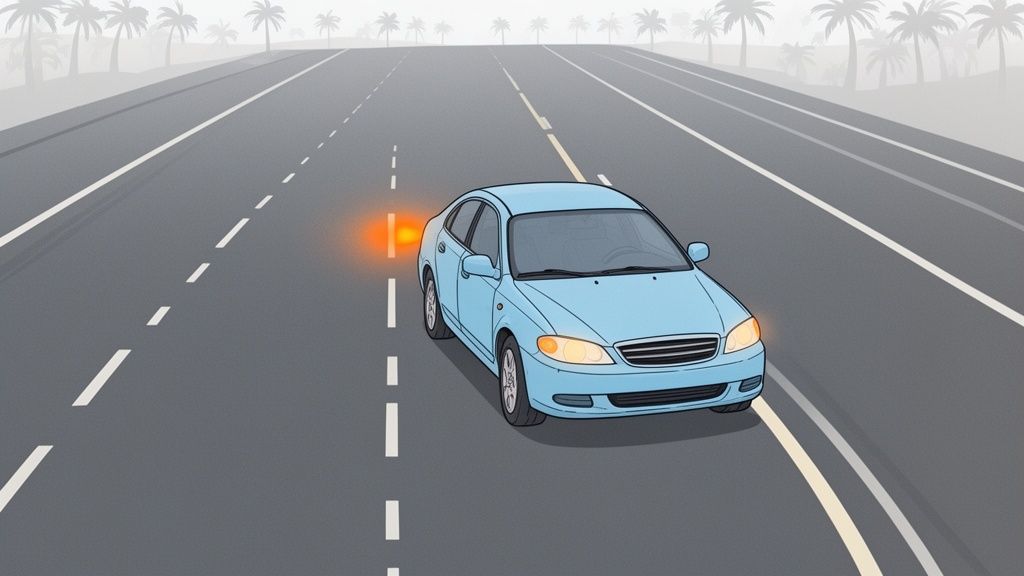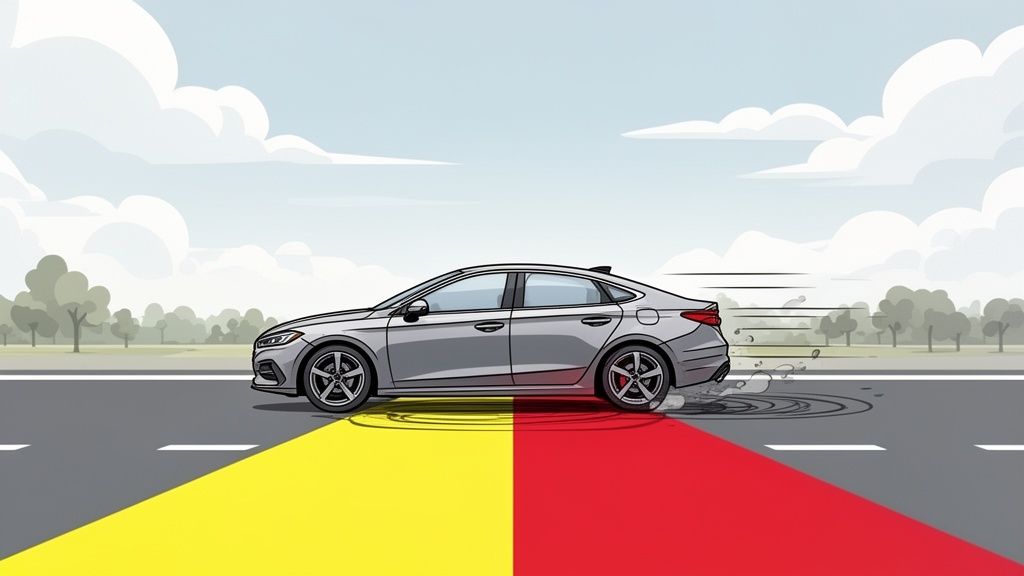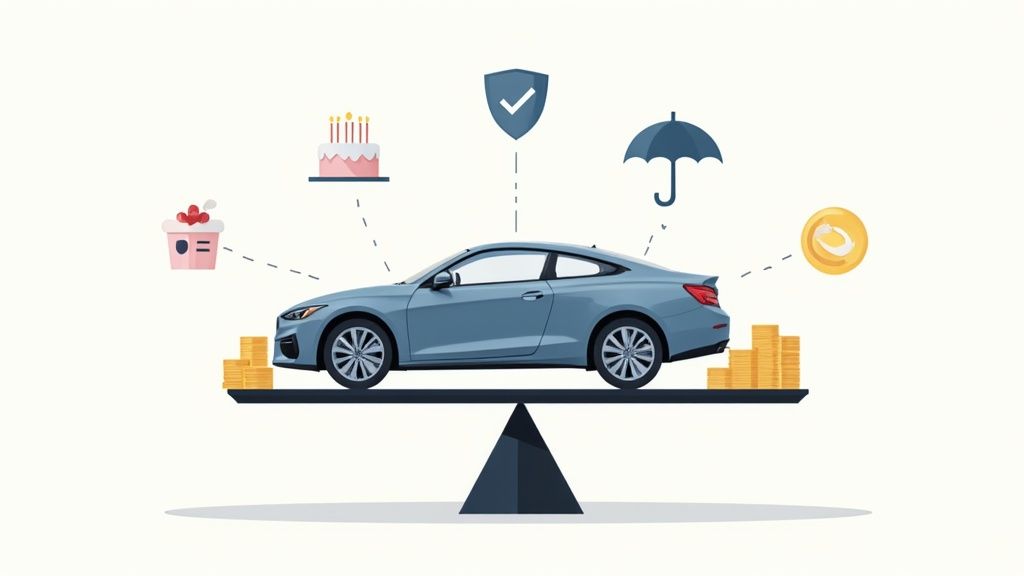Road safety is a top priority for every driver. At DriverEducators.com, we’ve compiled essential defensive driving tips to help you navigate the roads with confidence and reduce your risk of accidents.
These strategies will sharpen your awareness, improve your reaction time, and prepare you for unexpected situations on the road. By mastering these techniques, you’ll become a safer and more responsible driver.
How to Stay Alert and Focused While Driving
Staying alert and focused is the foundation of safe driving. This chapter explores practical strategies to enhance your focus and alertness behind the wheel.
Eliminate Distractions
Distracted driving causes many accidents. Turn off your phone or put it on silent mode before you start your journey. If you need your phone for navigation, set up your route before you drive and use a hands-free mount. Don’t eat, apply makeup, or do any other activities that take your hands off the wheel or eyes off the road.
Keep Your Eyes Moving
Scan your surroundings continuously while driving. Look ahead to spot potential hazards, check your mirrors every 5-8 seconds, and stay aware of vehicles in adjacent lanes. This practice (known as the Smith System) can significantly reduce your accident risk by improving your situational awareness.
Maintain a Safe Following Distance
The National Highway Traffic Safety Administration (NHTSA) recommends you keep at least a 3 or 4 seconds following distance in good weather conditions. To calculate this, select a stationary object ahead and count the seconds it takes for you to reach it after the car in front of you passes it. In adverse weather or when you drive larger vehicles, increase this distance.
Proper following distance gives you more time to react to sudden changes in traffic flow, which reduces the risk of rear-end collisions. It also allows you to see around the vehicle in front of you, providing better visibility of potential hazards ahead.
Use the “Two-Second Rule”
The “Two-Second Rule” is a simple technique to maintain a safe following distance. As the vehicle in front of you passes a fixed point (such as a road sign or lamp post), start counting “one thousand one, one thousand two.” If you reach the same fixed point before you finish counting, you’re following too closely. This rule works well in normal traffic conditions and can be adjusted for adverse weather (try a four-second count instead).
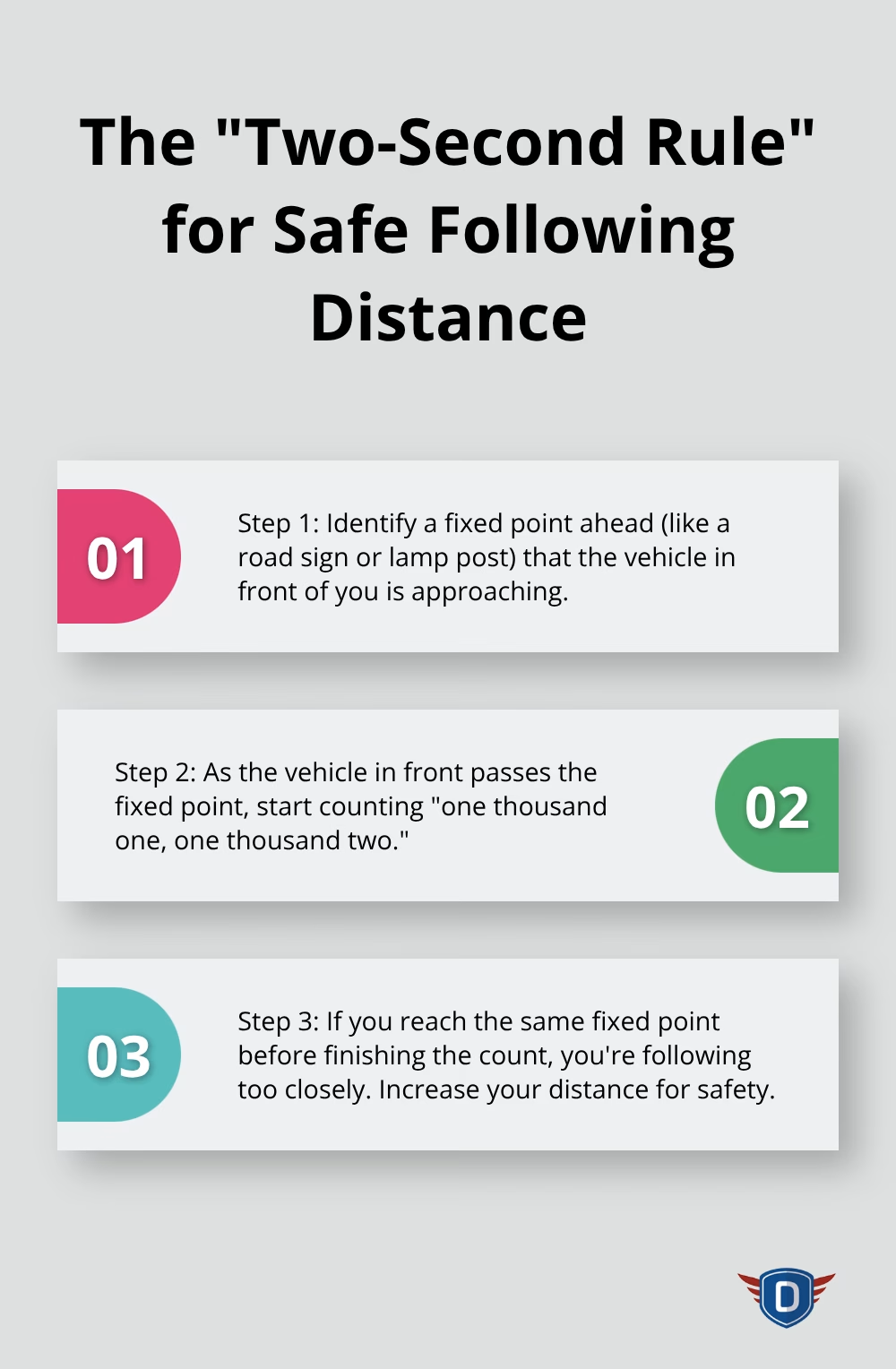
Take Regular Breaks
Long drives can lead to fatigue, which impairs your focus and reaction time. Plan to take a break every two hours or 100 miles (whichever comes first). Use these breaks to stretch your legs, get some fresh air, and refresh your mind. If you feel drowsy, don’t hesitate to pull over at a safe location and take a short nap.
Now that you’ve learned how to stay alert and focused, let’s move on to the next critical aspect of defensive driving: anticipating and preparing for potential hazards on the road.
How to Predict and Avoid Road Hazards
Defensive driving requires you to anticipate potential hazards before they become critical. This proactive approach can significantly reduce your risk of accidents and make your driving experience safer and less stressful.
Read the Road Ahead
Constant scanning of the road ahead is one of the most effective ways to anticipate hazards. Look for changes in traffic flow, such as sudden slowdowns or lane merges. Pay attention to brake lights in the distance, which could indicate upcoming congestion or an accident. The National Safety Council recommends looking 12 to 15 seconds ahead (about one block in city driving or a quarter-mile on the highway) to give you ample time to react to potential dangers.
Adapt to Weather Conditions
Weather can dramatically affect road conditions and visibility. When rain starts, prepare for slippery roads, especially in the first 10-15 minutes when water mixes with oil on the road surface. In snow or ice, reduce your speed by at least 50% and increase your following distance. The Federal Highway Administration reports that approximately 12% of vehicle crashes are weather-related, emphasizing the importance of adjusting your driving to match the conditions.
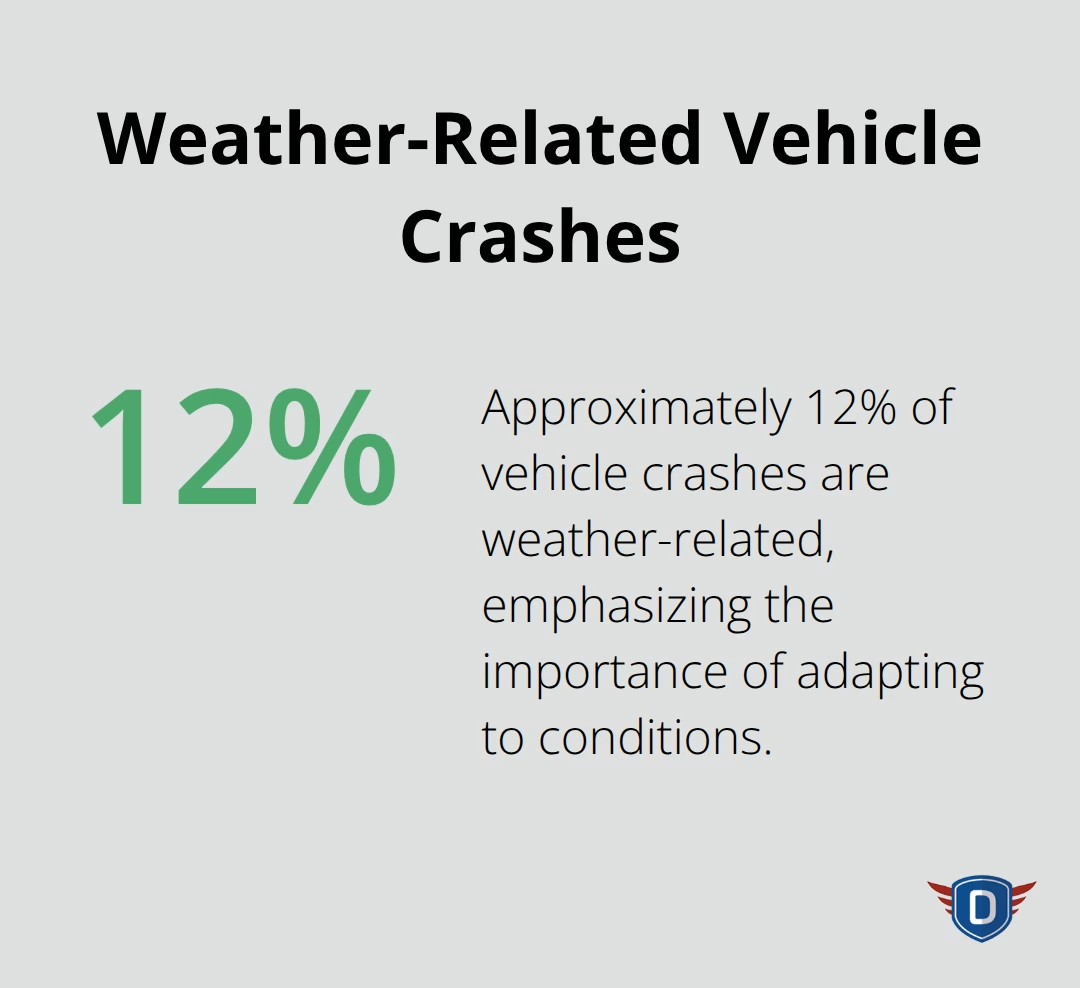
Watch for Vulnerable Road Users
Pedestrians, cyclists, and motorcyclists are often harder to spot and more vulnerable in accidents. Always check your blind spots before turning or changing lanes, especially in urban areas. The National Highway Traffic Safety Administration (NHTSA) states that in 2019, 6,205 pedestrians were killed in traffic crashes in the United States. This sobering statistic underscores the need for heightened awareness around crosswalks, intersections, and areas with high foot traffic.
Anticipate Other Drivers’ Actions
Never assume that another driver has seen you or will follow traffic rules. If you see a car weaving in its lane or driving erratically, give it a wide berth. The Insurance Institute for Highway Safety (IIHS) reports that driver error is the primary cause of 94% of crashes, highlighting the importance of staying vigilant and prepared for others’ mistakes.
Use the “What If” Technique
Try to use the “What If” technique while driving. Ask yourself questions like, “What if that car suddenly changes lanes?” or “What if that pedestrian steps off the curb?” This mental exercise (which takes only seconds) helps you prepare for potential scenarios and react more quickly if they occur.
These skills of prediction and preparation will equip you to handle whatever the road throws at you. Defensive driving is an active process that requires constant attention and adjustment. As you practice these techniques, they’ll become second nature, making you a safer and more confident driver. Now, let’s explore how to master specific defensive driving techniques that will further enhance your safety on the road.
How to Master Advanced Defensive Driving Techniques
Speed Management: The Foundation of Control
Proper speed management forms the foundation of defensive driving. From 2010 to 2019 speeding-related fatalities declined by 9.8 percent, from 10,508 in 2010 to 9,478 in 2019. You must always adhere to posted speed limits and adjust your speed based on road conditions. In wet weather, reduce your speed by at least 5-10 mph. On curves, slow down before entering the curve, not while you’re in it. This approach gives you better control and reduces the risk of skidding or losing control.
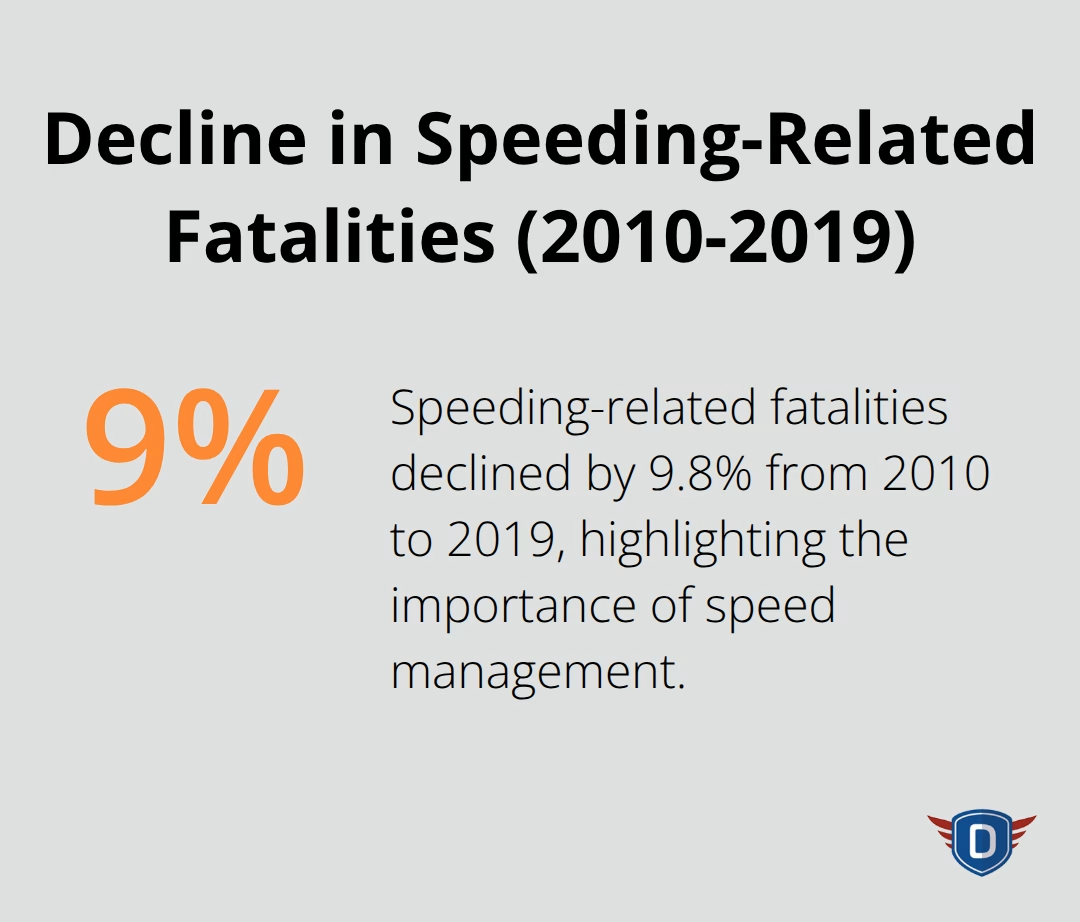
Effective Signaling: Clear Communication on the Road
Consistent use of turn signals is a simple yet powerful defensive driving technique. Both turns as well as lane change usage rates are important factors in road safety. You should signal your intentions at least 100 feet before turning or changing lanes in urban areas, and 300 feet on highways. This practice not only complies with most state laws but also gives other drivers time to anticipate and react to your movements.
The “Escape Route” Strategy: Always Have an Out
You must always maintain an escape route while driving. This means you should constantly identify a space around your vehicle where you can maneuver if an unexpected hazard appears. The Texas Department of Public Safety recommends leaving at least one car length of space in front of you when stopped in traffic. On highways, try to avoid driving directly alongside other vehicles for extended periods. These practices give you options to avoid potential collisions.
Reaction Time Enhancement: Quick Responses Save Lives
Improving your reaction time is essential for effective defensive driving. A study by the University of Iowa found that drivers with faster reaction times were involved in fewer accidents. Regular practice can help. Try this exercise: Have a passenger hold a small object at shoulder height and drop it without warning. Try to catch it before it hits your lap. This simple drill can help improve your reflexes and translate to quicker responses on the road.
Advanced Techniques: Elevating Your Defensive Driving Skills
To further enhance your defensive driving abilities, consider these advanced techniques:
- The “Two-Second Rule”: Maintain a minimum two-second gap between your vehicle and the one in front (increase this in adverse conditions).
- The “SIPDE” Process: Scan, Identify, Predict, Decide, and Execute. This systematic approach helps you process information and make decisions quickly.
- Proper Mirror Adjustment: Minimize blind spots by correctly positioning your mirrors (this can reduce the risk of lane-change accidents).
These advanced techniques require consistent practice to master. As you incorporate them into your daily driving, they’ll become second nature, ultimately making you a safer and more confident driver on the road.
Final Thoughts
Defensive driving tips require dedication and continuous practice to master. These strategies will reduce your accident risk and make you a safer driver on the road. Proactive driving prioritizes safety for yourself and others, going beyond just following traffic rules.
Road conditions and vehicle technologies evolve, necessitating ongoing education in driving skills. Regular practice and refresher courses reinforce good habits and introduce new techniques to enhance your defensive driving abilities. We at DriverEducators.com strive to help drivers of all levels improve their skills and confidence.
Our comprehensive driver education programs offer personalized guidance in a supportive learning environment. We encourage you to invest in your driving education to contribute to safer roads for everyone. Take the next step towards becoming a more skilled driver by embracing these defensive driving tips and considering enrollment in a course to further enhance your abilities.
